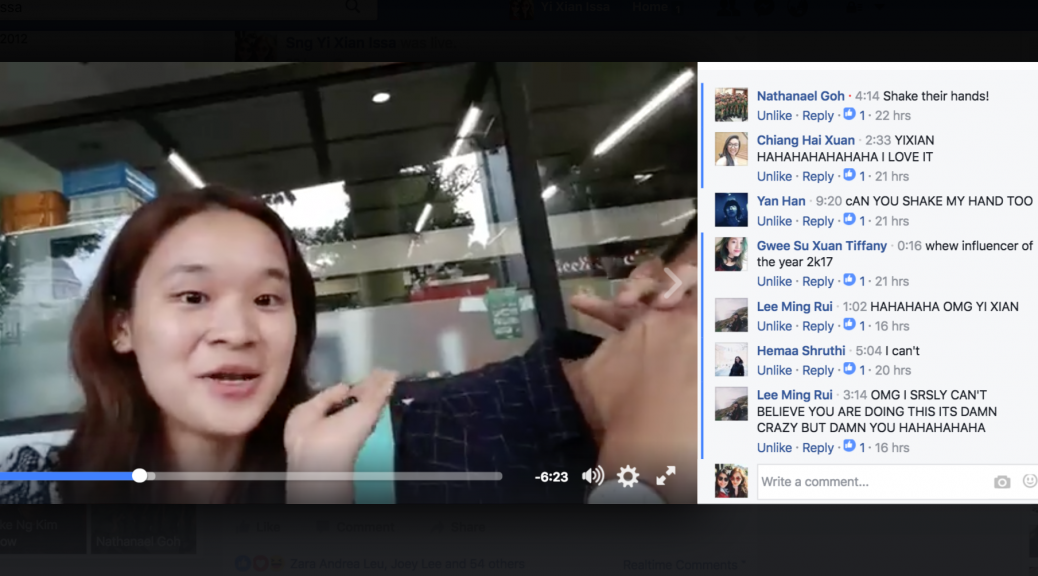Please click here for my 2nd Facebook Live broadcast. This post has been updated to include more information about influencers and online celebrities in Singapore’s social media landscape.
Some post-broadcast thoughts
This week I wanted to experiment with performance, persona, parody, and the context of social media live streaming.
Social media influencers and online celebrity beauty and lifestyle bloggers have become ubiquitous on the Internet and pop culture landscape. In Singapore, influencers have a sizeable following on social media, especially Instagram. A large subset of influencers are good-looking young women who offer fashion inspiration, beauty advice and are sometimes ‘famous for being famous’. Companies often approach influencers for product sponsorship (marketing through individuals) which they will share with their followers. These online personalities typically build their following on multiple social media platforms and may have accompanying Youtube channels with videos like makeup tutorials, fashion hauls and Q&As.



Although there are multiple positive aspects of social media and influencers, it has been criticised as rather narcissistic and unhealthy especially for youth, if they are too invested in online fame and followers.
It was very intimidating yet refreshing to take on a persona totally different from myself and commit to it unabashedly and without breaking character. I approached strangers in the SMU campus with the absurd proposition of giving them my autograph and convincing them to become my fans.
As part of the performance, I appropriated online vernacular (e.g. #follow4follow and “subscribe to my channel”) and the way online personalities interact with their fans locally and remotely through live streaming and ‘vlogging’.
Compared to my first broadcast, the second had more views and responses. This is probably because the broadcast was humorous and relatable to users of social media. It was heartwarming and surprising to see comments and reactions from people I haven’t been in touch with for years.

Nobel laureate Herbert Simon advocated ‘technologies of foolishness’ in order for creativity ti develop optimally. Your use of mobile technology epitomises Computer Supported Collaborative Learning in the arts un how your audience and unsuspecting SMU victims are pulled into your performance as active participants in an unfolding narrative that they continuously shape through the mobile technology.
Getting learners to be foolish or shameless is harder than it seems though, because Singaporean learners in particular are notoriously conformist and prefer to play it safe. Your work has evinced how technologies of foolishness or shamelessness are alive and well on OSS.
It takes in Simon’s words a certain foolishness to do what others dare not in order to surpass expectations and pish the boundaries of media art. More importantly, it take a humility and I argue even shamelessness to admit that as learners of an artform or of any discipline, there is so much we simply don’t know and have yet to know. Knowing is to daring be foolish – to do what others dare not. ‘Jia you’!
The Technology of Foolishness
Another Nobel laureate James March’s (1971, 1994, 2006), and Jude Chua (2009) also advocate a “technology of foolishness” rather than “technology of reason” to mitigate high stakes performative pressures that are pernicious to creative thinking and expression. They argue that performance anxiety and obsession with end results, often displace the enjoyment and wonder that make the exploratory process so much more important than the final product or outcome.
May the technology of foolishness or shamelessness as you’ve exemplified prevail at ADM!
References
Chua, S. M. J. (2009). Saving the teacher’s soul: exorcising the terrors of performativity. London Review of Education, 7(2), 159-167. doi: 10.1080/14748460902990344
March, J. G. (1971). The technology of foolishness, Civiløkonomen (Copenhagen), 18 (4), 4-12.
March, J. G. (1994). A premier on decision making: How decisions happen. NY: The Free Press.
March, J. G. (2006). Rationality, foolishness, and adaptive intelligence, Strategic Management Journal, 27 (3), 201-214.
Yikes. Wish there was a way to edit my typos after posting the comment.
By the way, how did you feel before, during and after the performance? What were you thinking? That we cannot from the video see.
This is an outstanding video performance. You seemed to warm to the role and persona as the video progresses. You might try beginning the video in character rather than providing the setup. This would make your character even more believable, particularly to the online audience.